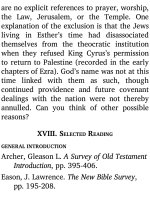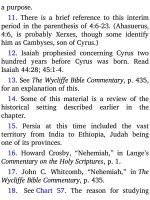Jensens survey of the old testament adam 620
Bạn đang xem bản rút gọn của tài liệu. Xem và tải ngay bản đầy đủ của tài liệu tại đây (203.93 KB, 4 trang )
following, comparing the items with your
own survey.
1. There are three main divisions of
Revelation. What are they? Why is a main
division made at chapter 6? Why one at
chapter 21? Note also the outline that
divides the book into two parts: “things
which are;” “things which shall be
hereafter.” These phrases come
CHART 123: REVELATION: THE REVELATION
OF JESUS CHRIST
from 1:19, where the time references are
brought out clearly: “Write therefore the
things which you have seen, and the things
which are, and the things which shall take
place after these things.” Why is the division
point for this outline made at chapter 4? As
of John’s day, what proportion of Revelation
was history yet to be ful lled? Compare also
1:1.
2. Judgments do not appear until chapter
6. How are chapters 1-5 introductory to the
judgments?
3. For clarity’s sake, a proportionately
larger space is devoted on the chart to the
three series of judgments than to the other
events. This trio (seals → trumpets → bowls)
is the unifying element of the judgments
division (chaps. 6-20).
4. How are the judgment series (seals,
trumpets, and bowls) related to each other?
Observe, for example, that the seventh seal
(8:1) constitutes the whole series of
trumpets; and the seventh trumpet (11:15)
constitutes the whole series of bowls. Is
there a seventh bowl? (See chapter 16.)
5. Note that there is a parenthesis, or
interlude, between the seals and trumpets
and between the trumpets and bowls. How
many chapters are involved in each
parenthesis? (See Chart 124.)
CHART 124: THE CONTEXT OF REVELATION
10:1-15:4
6. Observe the progression on Chart 123:
partial judgments — more severe judgments
— consuming and final judgments.
7. The great white throne judgment (chap.
20) is the nal judgment for mankind.
Beyond this there are no further judgments
cited in Revelation.
8. Observe on the chart how songs appear
just before each event or era of judgment.
9. Quantitatively, most of Revelation is
about judgment and con ict. What does this
reveal concerning one of the purposes of









